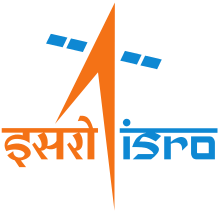Indian Regional Navigation Satellite System
The Indian Regional Navigation Satellite System (IRNSS), with an operational name of NavIC (acronym for Navigation with Indian Constellation; also, nāvik 'sailor' or 'navigator' in Sanskrit, and many other Indian languages),[3] is an autonomous regional satellite navigation system that provides accurate real-time positioning and timing services.[4] It covers India and a region extending 1,500 km (930 mi) around it, with plans for further extension. An extended service area lies between the primary service area and a rectangle area enclosed by the 30th parallel south to the 50th parallel north and the 30th meridian east to the 130th meridian east, 1,500–6,000 km (930–3,730 mi) beyond borders.[5] The system currently consists of a constellation of seven satellites,[1][6] with two additional satellites on ground as stand-by.[7]
| Country/ies of origin | India |
|---|---|
| Operator(s) | ISRO |
| Type | Military, Commercial |
| Status | Operational |
| Coverage | Regional (up to 1,600 km from borders) |
| Accuracy | 1 m or 3 ft 3 in (public) 10 cm or 3.9 in (encrypted) |
| Constellation size | |
| Total satellites | 8 |
| Satellites in orbit | 8 (IRNSS 1I launched completing the series) |
| First launch | 1 July 2013 |
| Last launch | 12 April 2018 |
| Total launches | 9 |
| Orbital characteristics | |
| Regime(s) | High Earth |
| Orbital height | 36,000 km (22,000 mi)[1] |
| Other details | |
| Cost | ₹22.46 billion (US$315 million), to March 2017[2] |
| Geodesy | ||||||||||||||||||||||||||
|---|---|---|---|---|---|---|---|---|---|---|---|---|---|---|---|---|---|---|---|---|---|---|---|---|---|---|
 | ||||||||||||||||||||||||||
|
Fundamentals |
||||||||||||||||||||||||||
|
Concepts |
||||||||||||||||||||||||||
|
Technologies
|
||||||||||||||||||||||||||
|
Standards (history)
|
||||||||||||||||||||||||||
The constellation is in orbit as of 2018, and the system was expected to be operational from early 2018[8][9] after a system check.[10] NavIC will provide two levels of service, the "standard positioning service", which will be open for civilian use, and a "restricted service" (an encrypted one) for authorised users (including the military).
NavIC based trackers are compulsory on commercial vehicles in India[11][12] and it is planned to become available in consumer mobile phones in the first half of 2020.[13]
There are plans to expand the NavIC system by increasing its constellation size from 7 to 11.[14]
Background
The system was developed partly because access to foreign government-controlled global navigation satellite systems is not guaranteed in hostile situations, as happened to the Indian military in 1999 when it was dependent on the American Global Positioning System (GPS) during the Kargil War.[15] The Indian government approved the project in May 2013.
As per National Defense Authorization Act (NDAA) 2020, United States Secretary of Defense in consultation with Director of National Intelligence will designate NavIC, Galileo and QZSS as allied navigational satellite system.[16]
Development
As part of the project, the Indian Space Research Organisation (ISRO) opened a new satellite navigation centre within the campus of ISRO Deep Space Network (DSN) at Byalalu, in Karnataka on 28 May 2013.[17] A network of 21 ranging stations located across the country will provide data for the orbital determination of the satellites and monitoring of the navigation signal.
A goal of complete Indian control has been stated, with the space segment, ground segment and user receivers all being built in India. Its location in low latitudes facilitates a coverage with low-inclination satellites. Three satellites will be in geostationary orbit over the Indian Ocean. Missile targeting could be an important military application for the constellation.[18]
The total cost of the project was expected to be ₹14.2 billion (US$199 million), with the cost of the ground segment being ₹3 billion (US$42 million), each satellite costing ₹1.5 billion (US$21 million) and the PSLV-XL version rocket costing around ₹1.3 billion (US$18 million). The planned seven rockets would have involved an outlay of around ₹9.1 billion (US$128 million).[7][19][20]
The necessity for two replacement satellites, and PSLV-XL launches, has altered the original budget, with the Comptroller and Auditor General of India reporting costs, to March 2017, at ₹22.46 billion (US$315 million)[2]
The NavIC signal was released for evaluation in September 2014.[21]
From 1 April 2019, use of AIS-140 compliant NavIC-based vehicle tracking systems were made compulsory for all commercial vehicles in India.[11][12]
In January 2020, Qualcomm launched three new chipsets, Snapdragon 720G, 662 and 460 with support for Navigation with Indian Constellation (NavIC).[22][23] NavIC is planned to be available for civilian use in mobile devices, after Qualcomm and Indian Space Research Organisation signed an agreement.[13][24]
Time-frame
In April 2010, it was reported that India plans to start launching satellites by the end of 2011, at a rate of one satellite every six months. This would have made NavIC functional by 2015. But the program was delayed,[25] and India also launched 3 new satellites to supplement this.[26]
Seven satellites with the prefix "IRNSS-1" will constitute the space segment of the IRNSS. IRNSS-1A, the first of the seven satellites, was launched on 1 July 2013.[27][28] IRNSS-1B was launched on 4 April 2014 on-board PSLV-C24 rocket. The satellite has been placed in geosynchronous orbit.[29] IRNSS-1C was launched on 16 October 2014,[30] IRNSS-1D on 28 March 2015,[31] IRNSS-1E on 20 January 2016,[32] IRNSS-1F on 10 March 2016 and IRNSS-1G was launched on 28 April 2016.[33]
The eighth satellite, IRNSS-1H, which was meant to replace IRNSS-1A, failed to deploy on 31 August 2017 as the heat shields failed to separate from 4th stage of the rocket.[34] IRNSS-1I was launched on 11 April 2018 to replace it.[35][36]
System description
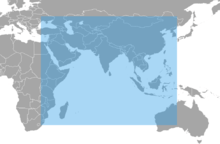
The IRNSS system comprises a space segment and a support ground segment.
Space segment
The constellation consists of 8 satellites. Three of the eight satellites are located in geostationary orbit (GEO) at 32.5° E, 83° E, and 131.5° E longitude, approximately 36,000 km (22,000 mi) above earth surface. Remaining five satellites are in inclined geosynchronous orbit (GSO). Two of them cross equator at 55° E and two at 111.75° E.[37][38] The four GSO satellites will appear to be moving in the form of an "8".[39]
Ground segment
Ground Segment is responsible for the maintenance and operation of the IRNSS constellation. The Ground segment comprises:[37]
- IRNSS Spacecraft Control Facility (IRSCF)
- ISRO Navigation Centre (INC)
- IRNSS Range and Integrity Monitoring Stations (IRIMS)
- IRNSS Network Timing Centre (IRNWT)
- IRNSS CDMA Ranging Stations (IRCDR)
- Laser Ranging Stations
- IRNSS Data Communication Network(IRDCN)
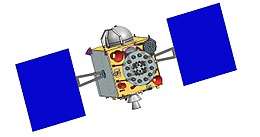
The INC established at Byalalu performs remote operations and data collection with all the ground stations. 14 IRIMS are currently operational and are supporting IRNSS operations. CDMA ranging is being carried out by the four IRCDR stations on regular basis for all the IRNSS satellites. The IRNWT has been established and is providing IRNSS system time with an accuracy of 2 ns (2.0×10−9 s) (2 sigma) w.r.t UTC. Laser ranging is being carried out with the support of ILRS stations around the world. Navigation Software is operational at INC since 1 August 2013. All the navigation parameters viz. satellite ephemeris, clock corrections, integrity parameters and secondary parameters viz. iono-delay corrections, time offsets w.r.t UTC and other GNSS, almanac, text message and earth orientation parameters are generated and uploaded to the spacecraft automatically. The IRDCN has established terrestrial and VSAT links between the ground stations. Seven 7.2-metre (24 ft) FCA and two 11-metre (36 ft) FMA of IRSCF are currently operational for LEOP and on-orbit phases of IRNSS satellites.[37][40]
Signal
NavIC signals will consist of a Standard Positioning Service and a Precision Service. Both will be carried on L5 (1176.45 MHz) and S band (2492.028 MHz).[41] The SPS signal will be modulated by a 1 MHz BPSK signal. The Precision Service will use BOC(5,2). The navigation signals themselves would be transmitted in the S-band frequency (2–4 GHz) and broadcast through a phased array antenna to maintain required coverage and signal strength. The satellites would weigh approximately 1,330 kg (2,930 lb) and their solar panels generate 1,400 W.
A messaging interface is embedded in the NavIC system. This feature allows the command center to send warnings to a specific geographic area. For example, fishermen using the system can be warned about a cyclone.[42]
Accuracy
The system is intended to provide an absolute position accuracy of better than 10 metres (33 ft) throughout Indian landmass and better than 20 metres (66 ft) in the Indian Ocean as well as a region extending approximately 1,500 km (930 mi) around India.[43] The Space Applications Centre in 2017 said NavIC will provide standard positioning service to all users with a position accuracy up to 5 m.[42] The GPS, for comparison, had a position accuracy of 20–30 m.[44] Unlike GPS which is dependent only on L-band, NavIC has dual frequency (S and L bands). When low frequency signal travels through atmosphere, its velocity changes due to atmospheric disturbances. US banks on atmospheric model to assess frequency error and it has to update this model from time to time to assess the exact error. In India's case, the actual delay is assessed by measuring the difference in delay of dual frequency (S and L bands). Therefore, NavIC is not dependent on any model to find the frequency error and is more accurate than GPS.[45]
List of satellites
The constellation consists of 7 active satellites. Three of the seven satellites in constellation are located in geostationary orbit (GEO) and four in inclined geosynchronous orbit (IGSO). All satellites launched or proposed for the system are as follows:
| Satellite | SVN | PRN | Int. Sat. ID | NORAD ID | Launch Date | Launch Vehicle | Orbit | Status | Remarks |
|---|---|---|---|---|---|---|---|---|---|
| IRNSS-1A | I001 | I01 | 2013-034A | 39199 | 1 July 2013 | PSLV-XL-C22 | Geosynchronous (IGSO) / 55°E, 29° inclined orbit | Partial Failure | Atomic clocks failed.The satellite is being used for NavIC's short message broadcast service.[47][48][49] |
| IRNSS-1B | I002 | I02 | 2014-017A | 39635 | 4 April 2014 | PSLV-XL-C24 | Geosynchronous (IGSO) / 55°E, 29° inclined orbit | Operational | |
| IRNSS-1C | I003 | I03 | 2014-061A | 40269 | 16 October 2014 | PSLV-XL-C26 | Geostationary (GEO) / 83°E, 5° inclined orbit | Operational | |
| IRNSS-1D | I004 | I04 | 2015-018A | 40547 | 28 March 2015 | PSLV-XL-C27 | Geosynchronous (IGSO) / 111.75°E, 31° inclined orbit | Operational | |
| IRNSS-1E | I005 | I05 | 2016-003A | 41241 | 20 January 2016 | PSLV-XL-C31 | Geosynchronous (IGSO) / 111.75°E, 29° inclined orbit | Operational | |
| IRNSS-1F | I006 | I06 | 2016-015A | 41384 | 10 March 2016 | PSLV-XL-C32 | Geostationary (GEO) / 32.5°E, 5° inclined orbit | Operational | |
| IRNSS-1G | I007 | I07 | 2016-027A | 41469 | 28 April 2016 | PSLV-XL-C33 | Geostationary (GEO) / 129.5°E, 5.1° inclined orbit | Operational | |
| IRNSS-1H | 31 August 2017 | PSLV-XL-C39 | Launch Failed | The payload fairing failed to separate and satellite could not reach the desired orbit.[34][50] It was meant to replace defunct IRNSS-1A.[48][14] | |||||
| IRNSS-1I | I009 | 2018-035A | 43286 | 12 April 2018 | PSLV-XL-C41 | Geosynchronous (IGSO) / 55°E, 29° inclined orbit | Operational | [51] | |
| IRNSS-1J | Geosynchronous (IGSO), 42° inclined orbit | Planned | |||||||
| IRNSS-1K | Geosynchronous (IGSO), 42° inclined orbit | Planned | |||||||
| IRNSS-1L | Geosynchronous (IGSO), 42° inclined orbit | Planned | |||||||
| IRNSS-1M | Geosynchronous (IGSO), 42° inclined orbit | Planned | |||||||
| IRNSS-1N | Geosynchronous (IGSO), 42° inclined orbit | Planned |
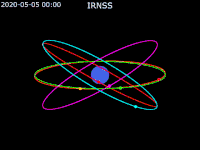
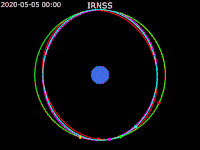

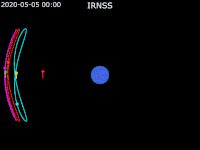
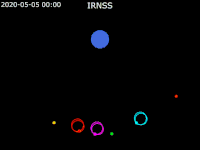
Clock failure
In 2017, it was announced that all three SpectraTime supplied rubidium atomic clocks on board IRNSS-1A had failed, mirroring similar failures in the European Union's Galileo constellation.[54][55] The first failure occurred in July 2016, followed soon after by the two other clocks on IRNSS-1A. This rendered the satellite non-functional and required replacement.[56] ISRO reported it had replaced the atomic clocks in the two standby satellites, IRNSS-1H and IRNSS-1I., in June 2017[14] The subsequent launch of IRNSS-1H, as a replacement for IRNSS-1A, was unsuccessful when PSLV-C39 mission failed on 31 August 2017.[14][57] The second standby satellite, IRNSS-1I, was successfully placed into orbit on 12 April 2018.[51]
In July 2017, it was reported that two more clocks in the navigational system had also started showing signs of abnormality, thereby taking the total number of failed clocks to five,[14] in May 2018 a failure of a further 4 clocks was reported, taking the count to 9 of the 24 in orbit.[58]
As a precaution to extend the operational life of navigation satellite, ISRO is running only one rubidium atomic clock instead of two in the remaining satellites.[14]
Future developments
India's Department of Space in their 12th Five Year Plan (FYP) (2012–17) stated increasing the number of satellites in the constellation from 7 to 11 to extend coverage.[59] These additional four satellites will be made during 12th FYP and will be launched in the beginning of 13th FYP in geosynchronous orbit of 42° inclination.[53][60] Also, the development of space-qualified Indian made atomic clocks was initiated,[61] along with a study and development initiative for an all optical atomic clock (ultra stable for IRNSS and deep space communication).[62][59]
IRNSS-1J, IRNSS-1K, IRNSS-1L, IRNSS-1M and IRNSS-1N are next batch of spacecrafts in development.[52]
Global Indian Navigation System (GINS)
Study and analysis for Global Indian Navigation System (GINS) was initiated as part of the technology and policy initiatives in the 12th FYP (2012–17).[62] The system is supposed to have a constellation of 24 satellites, positioned 24,000 km (14,913 mi) above Earth. As of 2013, the statutory filing for frequency spectrum of GINS satellite orbits in international space, has been completed.[63]
See also
- BeiDou Navigation Satellite System
- Galileo (satellite navigation)
- Global Positioning System
- GLONASS
- GPS Aided GEO Augmented Navigation
- Satellite navigation
- Quasi-Zenith Satellite System
References
- "Orbit height and info". Archived from the original on 30 December 2015.
- Datta, Anusuya (14 March 2018). "CAG pulls up ISRO on NavIC delays, cost overruns". Geospatial World.
- "IRNSS-1G exemplifies 'Make in India', says PM". The Statesman. 28 April 2016. Archived from the original on 23 September 2016. Retrieved 28 April 2016.
- "Satellites are in the sky, but long way to go before average Indians get Desi GPS".
- "IRNSS Programme - ISRO". www.isro.gov.in. Retrieved 14 July 2018.
- "IRNSS details". Archived from the original on 10 March 2016.
- "Isro to launch 5th navigation satellite on Jan 20, first in 2016". Hindustan Times. 18 January 2016.
- Rohit KVN (28 May 2017). "India's own GPS IRNSS NavIC made by ISRO to go live in early 2018". International Business Times.
- "Isro's PSLV-C32 places India's sixth navigation satellite IRNSS-1F in orbit". Times of India.
- "ISRO puts seventh and final IRNSS navigation satellite into orbit". Times of India.
- "Government of India, Ministry of Space, Lok Sabha - Unstarred Question number: 483 on Progress of IRNSS". 20 November 2019. Archived from the original on 17 February 2020. Retrieved 17 February 2020.
- "Government Of India, Ministry Of Space, Lok Sabha, Unstarred Question No: 675 on Indigenous GPS". 26 June 2019. Archived from the original on 17 February 2020. Retrieved 17 February 2020.
- "After Isro-Qualcomm pact, NavIC-compatible mobiles, navigation devices to hit market next year". The Times of India. 16 October 2019. Retrieved 16 October 2019.
- IANS (10 June 2017). "Navigation satellite clocks ticking; system to be expanded: ISRO". The Economic Times. Retrieved 24 January 2018.
- Srivastava, Ishan (5 April 2014). "How Kargil spurred India to design own GPS". The Times of India. Retrieved 9 December 2014.
- "US Congress consents to designate India's NavIC as allied system". The Economic Times. 11 December 2019. Retrieved 13 February 2020.
- "ISRO opens navigation centre for satellite system". Zeenews.com. 28 May 2013. Retrieved 30 June 2013.
- "India Making Strides in Satellite Technology". Defence News. Archived from the original on 6 June 2013. Retrieved 26 July 2012.
- "India's first ever dedicated navigation satellite launched". DNA India. 2 July 2013. Retrieved 24 July 2013.
- "India's first dedicated navigation satellite placed in orbit". NDTV. 2 July 2013. Retrieved 24 July 2013.
- "IRNSS Signal in Space ICD Released". GPS World. 25 September 2014. Retrieved 7 September 2016.
- Sarkar, Debashis (21 January 2020). "Qualcomm launches three chipsets with Isro's Navic GPS for Android smartphones". The Times of India.
- "Launch of mobile chipset compatible to NavIC - ISRO". Department of Space, Indian Space Research Organisation. Retrieved 22 January 2020.
- "NavIC support in upcoming Mobile, Automotive and IoT Platforms is poised to deliver superior Location-Based services to India's Industries and Technology Ecosystem Through Qualcomm". Indian Space Research Organisation. 14 October 2019. Retrieved 19 October 2019.
- S. Anandan (10 April 2010). "Launch of first satellite for Indian Regional Navigation Satellite system next year". The Hindu. Beta.thehindu.com. Retrieved 30 December 2010.
- H. Pathak. "3 Satellites To Be Launched By ISRO". Archived from the original on 17 April 2011.
- "ISRO's Future programme". ISRO. Retrieved 18 May 2013.
- "Countdown begins for PSLV-C22 launch". thehindubusinessline.com. Retrieved 29 June 2013.
- "Isro successfully launches navigation satellite IRNSS-1B". Times Of India. Retrieved 4 April 2014.
- "ISRO puts India's Navigation satellite IRNSS 1B into orbit". IANS. news.biharprabha.com. Retrieved 4 April 2014.
- "India successfully launches IRNSS-1D, fourth of seven navigation satellites – Times of India". indiatimes.com. Retrieved 7 September 2016.
- "India launches 5th navigation satellite IRNSS-1E powered by PSLV rocket". hindustantimes.com. 20 January 2016. Retrieved 20 January 2016.
- Narasimhan, T. E. (29 April 2016). "India gets its own GPS with successful launch of 7th navigation satellite". business-standard.com. Retrieved 7 September 2016.
- "ISRO says launch of navigation satellite IRNSS-1H unsuccessful". The Economic Times. 31 August 2017. Retrieved 31 August 2017.
- "IRNSS-1I". www.isro.gov.in. Indian Space Research Organisation. Retrieved 19 October 2019.
- "PSLV-C41/IRNSS-1I". www.isro.gov.in. Indian Space Research Organisation. 12 April 2018. Retrieved 19 October 2019.
- "IRNSS". www.isac.gov.in. Retrieved 8 June 2017.
- "First IRNSS satellite by December". Magazine article. Asian Surveying and Mapping. 5 May 2009. Retrieved 5 May 2009.
- "How Kargil spurred India to design own GPS". The Times of India. 5 April 2014. Retrieved 28 April 2016.
- K. Radhakrishnan (29 December 2013). "Mars and more, final frontier". Deccan Chronicle. Retrieved 28 April 2016.
- https://www.isro.gov.in/sites/default/files/irnss_sps_icd_version1.1-2017.pdf
- "Indian 'GPS' for public use by year-end – Times of India". The Times of India. Retrieved 8 June 2017.
- A. Bhaskaranarayana Director SCP/FMO & Scientific Secretary Indian Space Research Organisation – Indian IRNSS and GAGAN Archived 5 December 2010 at the Wayback Machine
- "India's desi GPS 'NavIC' all set to navigate you".
- "Get ready! India's own GPS set to hit the market early next year - Times of India".
- "IGS MGEX NavIC". mgex.igs.org. Retrieved 17 July 2019.
- "Annual Report 2019-20". Department of Space. Retrieved 5 March 2020.
- Mukunth, Vasudevan. "3 Atomic Clocks Fail Onboard India's 'Regional GPS' Constellation". thewire.in. Retrieved 8 June 2017.
- D.S., Madhumathi. "Atomic clocks on indigenous navigation satellite develop snag". The Hindu. Retrieved 8 June 2017.
- "IRNSS-1H launch unsuccessful, says ISRO". The Indian Express. 31 August 2017. Retrieved 31 August 2017.
- "India completes NavIC constellation with 7th satellite - Times of India". The Times of India. Retrieved 11 April 2018.
- "Annual Report of Department of Space 2018-19" (PDF). 28 May 2019. Archived (PDF) from the original on 27 May 2019. Retrieved 13 November 2019.
- "The Interoperable Global Navigation Satellite Systems Space Service Volume" (PDF). pp. 62, 95. Archived (PDF) from the original on 26 November 2018. Retrieved 13 November 2019.
- "SpectraTime to Supply Atomic Clocks to IRNSS | Inside GNSS". www.insidegnss.com. Archived from the original on 26 June 2017. Retrieved 21 June 2017.
- "Spectratime Awarded Contract To Supply Rubidium Space Clocks To IRNSS". www.spacedaily.com. Retrieved 21 June 2017.
- D.S., Madhumathi. "Atomic clocks on indigenous navigation satellite develop snag". The Hindu. Retrieved 31 January 2017.
- Vasudevan Mukund (2 September 2017). "India's 'GPS' Remains Unfinished". The Wire. Wayback Machine. Archived from the original on 26 January 2018. Retrieved 26 January 2018.
- D.s, Madhumathi (5 May 2018). "ISRO's clock to prop up India's own GPS". The Hindu. ISSN 0971-751X. Retrieved 21 December 2019.
- "Five Year Plan" (PDF). Department of Space. 12th FYP: 96. October 2011.
- "12th Five Year Plan report, Department of Space, DST" (PDF). www.dst.gov.in. Retrieved 21 June 2017.
- "ISRO to test space robustness of indigenous atomic clocks this December". The Indian Express. 16 May 2018. Retrieved 13 November 2019.
- http://www.dst.gov.in/sites/default/files/14-wg_dos2905-report.pdf
- "Global Indian Navigation system on cards". The Hindu Business Line. 14 May 2010. Retrieved 22 June 2017.
Footnotes
- ^ SATNAV Industry Meet 2006. ISRO Space India Newsletter. April – September 2006 Issue.
